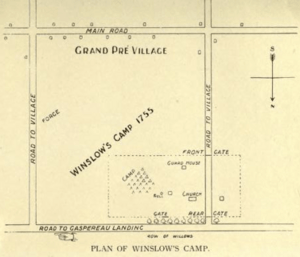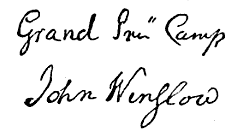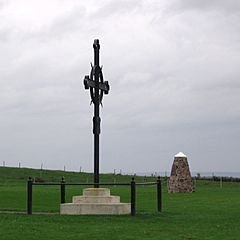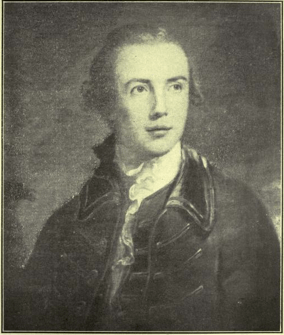Bay of Fundy campaign facts for kids
Quick facts for kids Bay of Fundy campaign |
|||||||
|---|---|---|---|---|---|---|---|
| Part of French and Indian War | |||||||
 John Winslow, British commander |
|||||||
|
|||||||
| Belligerents | |||||||
|
|||||||
| Commanders and leaders | |||||||
| John Winslow Captain Alexander Murray |
Charles Deschamps de Boishébert et de Raffetot Joseph Broussard |
||||||
| Units involved | |||||||
| 40th Regiment of Foot | Acadia militia Wabanaki Confederacy (Maliseet militia and Mi'kmaq militia) |
||||||
The Bay of Fundy campaign was a series of events during the French and Indian War. This war was a big conflict in North America, part of an even larger war called the Seven Years' War. The campaign happened when the British decided to remove the Acadians from their homes in Acadia. This decision came after the Battle of Fort Beauséjour in 1755.
The campaign started in a place called Chignecto. It then quickly moved to other areas like Grand-Pré, Rivière-aux-Canards, Pisiguit, Cobequid, and finally Annapolis Royal. In total, about 7,000 Acadians were forced to leave their homes. They were sent to the New England colonies, which are now part of the United States.
Contents
Why the Campaign Happened
The British took control of Acadia in 1710. For the next 45 years, the Acadians living there refused to promise their full loyalty to Britain. They did not want to take an unconditional oath.
During this time, Acadians often helped in small military actions against the British. For example, they took part in raids on places like Dartmouth, Nova Scotia. The Acadians also supplied important goods to the French fortresses of Louisbourg and Fort Beauséjour.
When the French and Indian War began, the British wanted to stop any military threat from the Acadians. They also wanted to cut off the supplies the Acadians were sending to the French. To do this, the British decided to deport, or remove, the Acadians from Acadia. Before the forced removal began, the British collected the Acadians' weapons and boats. They also arrested their local leaders and priests in the Bay of Fundy area.
The Campaign Begins
Chignecto Area
After the French Fort Beauséjour fell in 1755, the first part of the Acadian removal began in the Chignecto region. On August 10, Lieutenant-Colonel John Winslow led British troops. Under the command of Colonel Robert Monckton, Winslow captured 400 Acadian men at Fort Cumberland. These men were not expecting to be taken prisoner. Winslow also held 86 Acadians at Fort Lawrence. This was about one-third of the men in the area. Many other Acadians managed to escape. The prisoners were held in the forts until ships arrived to take them away. Their wives and children joined them when it was time to leave.
About a month after the removal started, on September 2, Boishébert organized a resistance. He gathered Mi'kmaq and Acadian fighters in the region. They strongly defeated the British forces in the Battle of Petitcodiac. Almost a month later, on October 1, the Acadian prisoners at Fort Lawrence escaped. Joseph Broussard (also known as Beausoleil) was one of those who got away.
On October 13, a group of eight transport ships left Chignecto Basin. They carried about 1,782 prisoners. Three British warships escorted them. The Acadians from Chignecto were seen as the most rebellious. Because of this, they were sent the farthest away from Acadia, to South Carolina and Georgia. As the ships left, Monckton started burning Acadian villages. This was to stop the Acadians from returning to their homes.
On November 15, 1755, British officer John Thomas burned the village of Tentatmar (now Sackville, New Brunswick). He destroyed the church and 97 other buildings there.
Cobequid Area
On August 15, Captain Thomas Lewis and Abijah Willard led 250 troops. They were ordered by Monckton to destroy two villages in Cobequid: Tatamagouche and Remsheg (now Wallace, Nova Scotia). The British chose to destroy these villages first. This was because they were important routes for Acadians to send cattle and food to Louisbourg.
Willard gathered the men of Tatamagouche in an Acadian home. He made sure all guns in the village were taken away. Then he told the Acadian men they were prisoners. Willard immediately began to destroy the cattle and food that were ready to be sent to Louisbourg. On August 16, Lewis burned 12 homes and the chapel. Willard continued to burn four houses and several barns on August 17.
Captain Lewis then went with 40 men to Remsheg. There, he captured three families and burned several buildings. Lewis returned to Fort Cumberland on August 26 with the Acadian male prisoners. What happened to the women and children from this area is not known.
On September 11, Captain Lewis was sent from Fort Cumberland again. His mission was to destroy the rest of Cobequid. This region included today's Truro, Nova Scotia. It stretched around to Petite Rivière (now Walton, Nova Scotia) on the south shore of Cobequid Bay. It also included Five Islands, Nova Scotia on the north shore. Lewis found that most of Cobequid was empty. Many people, like Noël Doiron, had already left their farms in the past five years. They had moved to Ile Saint-Jean (now Prince Edward Island). From September 23 to 29, Lewis destroyed the countryside by burning it.
Grand Pré Area
On August 18, 1755, Lieutenant Colonel John Winslow arrived in Grand-Pré with 315 troops. He set up his headquarters in the local church. Eight days earlier, Acadians had been imprisoned at Chignecto.
On September 5, all 418 Acadian males (age 10 and older) from the Grand Pré area were ordered into the Saint-Charles-des-Mines church. They were unexpectedly held there for five weeks. Winslow told them that all their belongings, except personal items, would be taken by the British Crown. He also said that they and their families would be deported as soon as ships arrived. The wives were ordered to feed and clothe both the prisoners and the troops. Six days after the initial imprisonment, Winslow moved 230 prisoners onto ships. This was because he feared an Acadian rebellion.
On October 13, over 2,000 Acadians were loaded onto five transport ships. They were taken from the landing on the Gaspereau River to the ships anchored at the river's mouth. As they left, Winslow began burning the Acadian villages. This was to prevent the Acadians from returning. He wrote that he burned 276 barns, 255 homes, 11 mills, and one church in the villages around Grand Pré.
Piziquid Area
At the exact same time Winslow read the expulsion orders in Grand Pré, Captain Alexander Murray read the order. This was on September 5 at 3:00 PM. He read it to the 183 Acadian males he had imprisoned at Fort Edward. On October 20, 920 Acadians from Piziquid were loaded onto four transport ships.
Unlike Grand Pré, the buildings at Pisiquid were not burned down. So, when new settlers from New England arrived, many houses and barns were still standing.
In April 1757, a group of Acadians and Mi'kmaq attacked a warehouse near Fort Edward. They killed 13 British soldiers. After taking supplies, they set the building on fire. A few days later, the same group also raided Fort Cumberland.
While they were prisoners, the Acadians were made to help the New England settlers. They helped them set up their farms. When the war ended, many Acadians did not want to stay and work for others. Instead, they moved to join other Acadians in what is now New Brunswick and Saint Pierre and Miquelon.
Annapolis Royal Area
At Annapolis Royal, Major John Handfield was in charge of removing the Acadians. The removal was slow in this area. But finally, on December 8, 1755, Acadians were put on seven ships. A warship escorted them. About 300 Acadians are said to have escaped being deported.

One ship, the snow Edward, was commanded by Ephraim Cook (mariner). It was lost at sea for months before finally arriving in Connecticut.
Of the ships that left on December 8, 32 Acadian families (225 prisoners) were on the British ship Pembroke. This ship was headed for North Carolina. However, these Acadians took control of the vessel. On February 8, 1756, the Acadians sailed the ship up the Saint John River as far as they could. They got off the ship and burned it. A group of Maliseet people met them. They guided them further upstream, where they joined a growing Acadian community. The Maliseet took them to one of Charles Deschamps de Boishébert et de Raffetot's camps for Acadians who were trying to escape. This camp was at Beaubears Island.
Some Acadian families living further up the Annapolis River fled into the forests. They went to the North Mountain near Morden, Nova Scotia. Many of them died during the winter that followed. Then, a Mi'kmaw group helped the survivors escape in the spring. They crossed the Bay of Fundy to Refugee Cove at Cape Chignecto. From there, they went into the interior of New Brunswick.
In December 1757, John Weatherspoon was cutting firewood near Fort Anne. He was captured by Indigenous people (likely Mi'kmaq). They took him to the mouth of the Miramichi River. From there, he was eventually sold or traded to the French. He was taken to Quebec and held until late 1759. This was when General Wolfe's forces won the Battle of the Plains of Abraham.
About 50 or 60 Acadians who escaped the first removal went to the Cape Sable region. This area included southwestern Nova Scotia. From there, they took part in many raids on Lunenburg, Nova Scotia.
What Happened Next
By the end of this campaign, more than 7,000 Acadians had been sent away to the New England States. The French, Indigenous people, and Acadians continued to fight against the British. They used guerrilla warfare for the next four years. An example is the raids on Lunenburg, Nova Scotia.
A second wave of Acadian removal began after the siege of Louisbourg (1758). The British then carried out other campaigns. These included the St. John River campaign, the Petitcodiac River campaign, the Ile Saint-Jean campaign, and the removal of Acadians in the Gulf of St. Lawrence campaign (1758).
Primary Sources
- Journal of Jeremiah Bancroft






